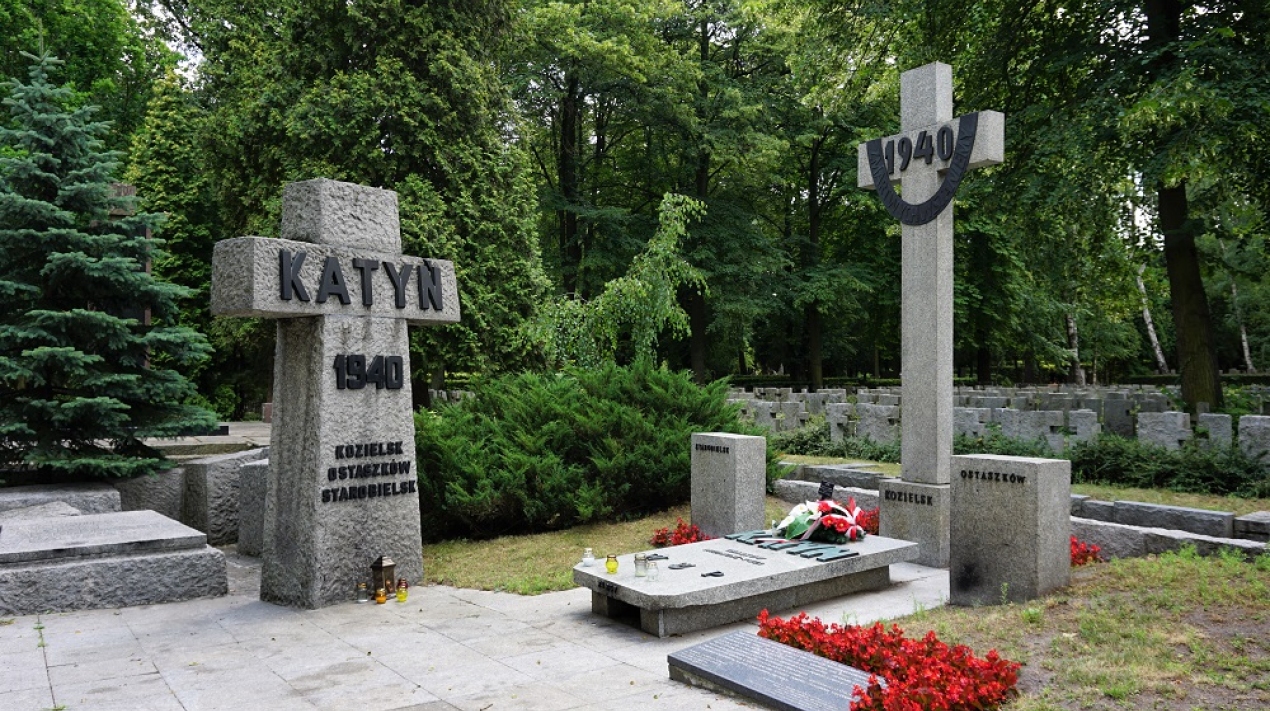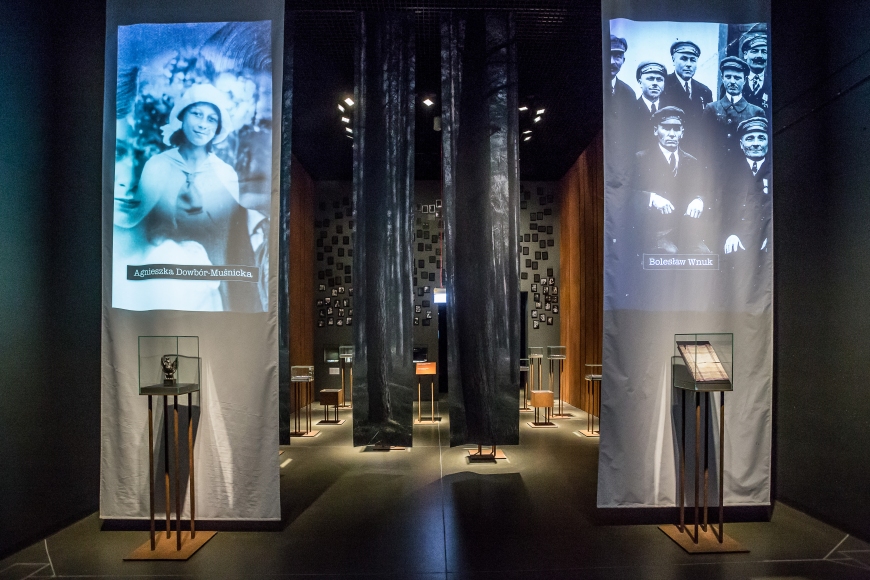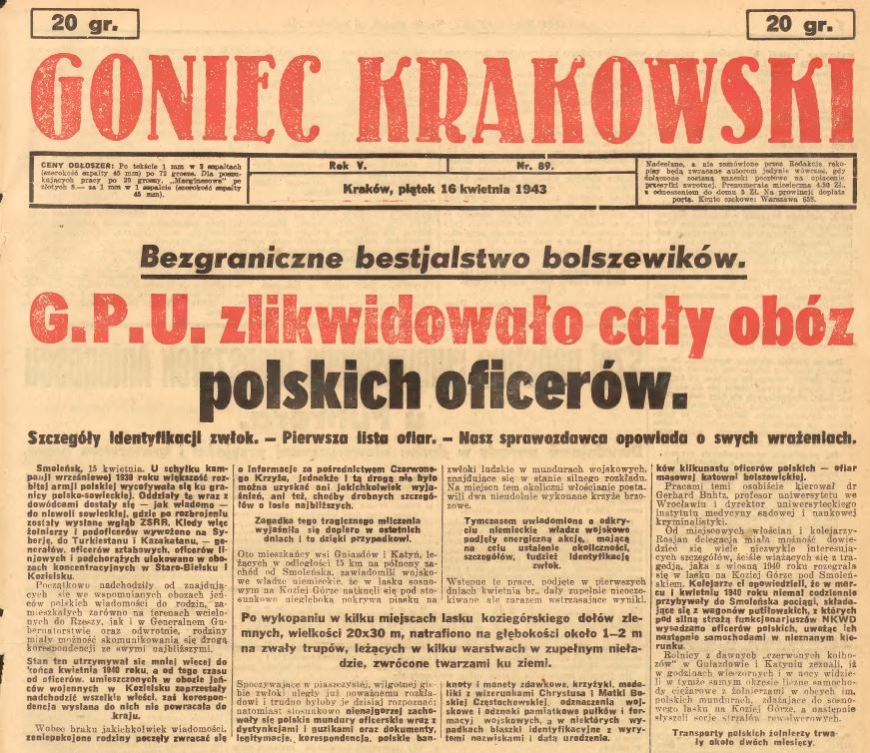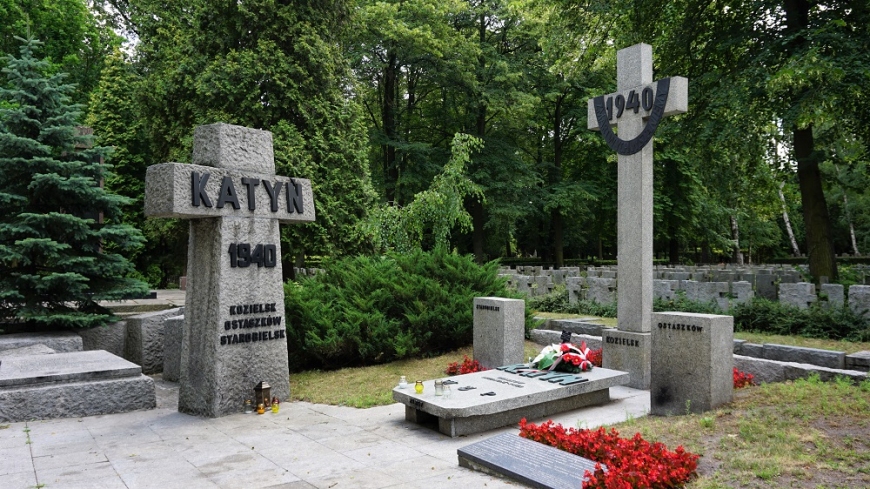DAY OF REMEMBRANCE FOR THE VICTIMS OF THE KATYN MASSACRE
The genocide in the Katyn Forests, carried out just a few months after the outbreak of World War II, became indicative of the Soviet state’s true intentions towards Poland. The hidden collusion between Hitler and Stalin led to the tragic extermination of the Polish elite. The Katyn Lie is a stark example of how the communists falsified history and stripped dignity from the victims.
The date directly references April 13th, 1943. On that day, at a conference in Berlin, the Germans officially announced that they had discovered mass graves of Polish officers in the forests near Katyn. However, it is important to remember that the indirect cause of the Katyn massacre was the collusion between Hitler and Stalin and the Soviet aggression against Poland on September 17th, 1939. From that moment, Poles living in the eastern provinces of the Republic had to contend not only with brutal Sovietization but also with deportations deep into the Soviet Union. The Soviet terror apparatus, following orders from Moscow, particularly targeted the Polish elite. Polish Army officers, officials, representatives of the academic intelligentsia, clergy, artists, and doctors were sent to prisoner-of-war camps in Kozelsk, Ostashkov, and Starobelsk, where they had to remain from the autumn of 1939 to the spring of 1940. One of those unlawfully imprisoned was Stefan Wąsowski, a doctor from Lublin, who volunteered for the army after the outbreak of World War II. By April 9th, 1940, he was in the Kozelsk POW camp, from where he was transported to the execution site in the Katyn Forest and shot. The details of this story can be found in the illustrated book ‘Katyn’.
The fate of those who formed the pre-war elite of the Republic, who fell into Soviet captivity in the first months of World War II, was sealed by the recommendation of the NKVD Soviet secret service chief Lavrentiy Beria in March 1940. In this document, Polish prisoners were deemed particularly dangerous to the Soviet regime; Stalin endorsed the proposal that they be murdered without trial or formal charges. The Soviet NKVD executioners meticulously carried out the dictator's will. The liquidation of the POW camps began. Unaware of their death sentence, Poles were transported to hidden execution sites in forested areas. In a brutal manner – with shots to the back of the head – nearly 22,000 people were killed.
After the Third Reich's invasion of the Soviet Union on June 22nd, 1941, former allies Hitler and Stalin became fierce enemies. This allowed the Polish Government-in-Exile to collaborate with Moscow to defeat Germany. One result of the agreements between Poland and the USSR was an amnesty for Polish prisoners in the Soviet Union. Indeed, thanks to the negotiations of Polish diplomats, it was possible to release Poles from Soviet labor camps to join the newly formed armed forces. Despite the Polish efforts, however, thousands of Polish officers remained unaccounted for. Until April 1943, their fates were unknown.
The public revelation by the Germans of the scale of Soviet crimes in the Katyn Forest had an obvious propagandistic purpose. According to Joseph Goebbels, it was a "political scandal that could have wide repercussions”. The Germans did not aim to honor Polish citizens; they wanted to highlight Soviet brutality to justify their own crimes. It is no wonder that the shocking information about the Katyn massacre resonated widely, with the involvement of delegations from various countries and contemporary media, including Polish journalists working for German-controlled Polish-language newspapers in occupied Poland – the so-called ‘gadzinówka’ press. More details on this topic can be found in the article by Professor Tadeusz Wolsza titled ‘Katyn Films (1943–1953)’, published in the journal ‘War and remembrance’. It juxtaposes the conflicting narratives about the Katyn massacre depicted in documentary films created by Soviets, Germans, and Poles.
Despite the clear propagandistic framing, all the facts revealed by the Germans from the beginning indicated that the executioners, on Stalin's orders, were NKVD operatives. The Soviets consistently shifted the blame to the Germans, reinforcing the Katyn Lie. The primary creator of this lie was Stalin himself. During a meeting with Władysław Sikorski on December 4th, 1941, when asked about the fate of Polish prisoners, Stalin replied that they had been released from the camps and probably escaped to Manchuria. After April 13th, 1943, Poland's allies, the British and Americans, were convinced that the Soviets were behind the 1940 massacre of Polish elites; this conviction is confirmed by numerous source materials. However, valuing their military alliance with Stalin, the Allies did not openly demand an explanation of this tragedy. When the Polish side called for an independent commission under the auspices of the International Red Cross, Stalin formally severed diplomatic relations with the Polish government in the West, accusing it of supporting German ‘lies’. For the Soviet dictator, this was also a convenient pretext to distance himself from the official Polish authorities and gradually implement the plan to Sovietize Poland.
***
The tragedy of the Katyn massacre is also the story of the Katyn Lie, which proved exceptionally enduring. It was officially repeated in the so-called People's Republic of Poland for nearly half a century, even though the communists themselves condemned Stalin's crimes in the 1950s. The theme of propagating the Katyn Lie is also addressed in the article by Michał Kozłowski titled ‘Juliusz Bardach – Katyn Liar’, published in the journal ‘War and Remembrance’. For decades after World War II, the communists either remained silent about Katyn or repeated the narrative outlined by Stalin. Until 1989, history textbooks in Poland and the few studies on the subject blamed Nazi Germany. The truth about the massacre in the Katyn Forest was known and propagated only within the domestic and émigré circles of democratic opposition. It was not until 1990 that Mikhail Gorbachev publicly admitted that it was "one of the gravest crimes of Stalinism," and the Katyn Lie lost its validity.
***
The Day of Remembrance for the Victims of the Katyn Massacre was officially established on April 13th by a resolution of the Polish Parliament on November 14th, 2007. The document paid tribute to the victims of Soviet crimes, who were murdered by the decision of March 5th, 1940. Earlier, from 1990 to 2007, Poland observed the World Day of Katyn Victims Remembrance.


















